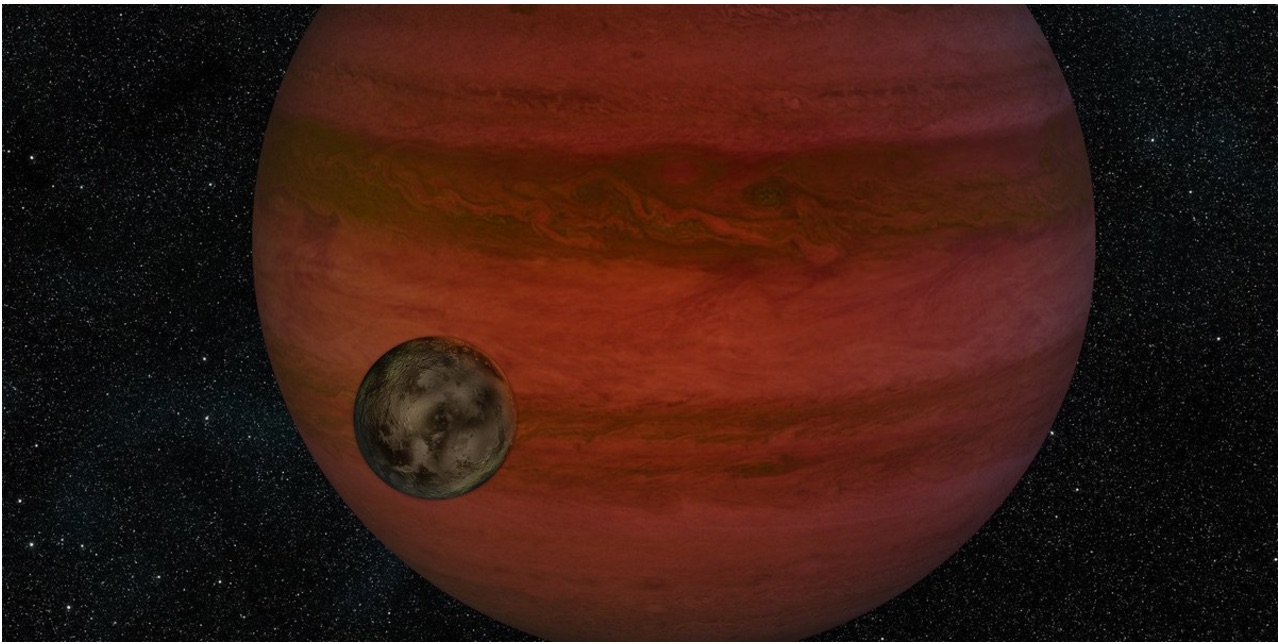NASA's Kepler Mission Could Detect Exomoons Formed by Giant Impacts

In 2012, a team of scientists from the Kepler mission announced they would start to hunt for moons orbiting distant exoplanets. While Kepler has discovered thousands of extrasolar planets, the hunt for these so-called "exomoons" has so far come up empty.
The major problem has been that for a moon to be detectable in the Kepler data, it would have to be about 10 percent the mass of Earth, or roughly the mass of Mars. This is about ten times larger than the largest moons in our own solar system.
While the formation of planetary satellites seems to be a natural by-product of planet formation, scientist Amy Barr of the Planetary Science Institute (PSI) wondered if it would be possible for large moons — possibly even Earth-like habitable moons — to form. And if so, could they possibly be common in the galaxy?
Using modeling and simulations, Barr and her fellow researchers found it is theoretically possible for super-sized moons to form around both rocky and gas planets, but only if the planets themselves are sufficiently large enough. Large rocky moons could be created from collisions between super-Earth sized rocky worlds, and exomoons around gas giants may be able to form by co-accretion or capture.
RELATED: Hunting for Exomoons That May Host Alien Life
"Our results are the first to demonstrate the masses of the moons that could form in the varied set of impact conditions possible within exoplanetary systems," said Barr, a senior scientist at PSI. "Most importantly, we have shown that it is possible to form exomoons with masses above the theoretical detection limits of the ongoing Hunt for Exomoons with Kepler survey, moons of more than a tenth of an Earth mass."
Just as the Kepler spacecraft used the transit method to detect planets passing in front of the disc of the parent star — which causes a temporary drop in brightness — the transit method should also be the best and most direct method for detecting exomoons. That's why a team at the Harvard-Smithsonian Center for Astrophysics started the Hunt of Exomoons with Kepler (HEK) project. But finding exomoons has been a fruitless challenge, mostly because of the size needed for the moon to be detectable.
Get the Space.com Newsletter
Breaking space news, the latest updates on rocket launches, skywatching events and more!
However, solar systems found by Kepler are quite different than our own, and the most common size of planet in the Kepler data is new class of planets called super-Earths. These are planets between the size of Earth and Neptune, which we don't have in our own cosmic neighborhood.
"Very little is known about how the satellite formation processes proposed for our solar system might scale to different planetary masses and stellar conditions," wrote Barr in her paper.
Using hydrodynamical simulations — which have been used to study how Earth's moon may have formed by a large impact — Barr was able to determine how much material would be launched into orbit by the collision of two rocky super-Earth exoplanets. Collisions between rocky planets with masses of two to seven Earth masses can launch into orbit enough mass to create a satellite large enough to be detected in Kepler transit data.
"These outcomes are broadly similar to the Moon-forming impact, but when two super-earths collide, the disk is much hotter and more massive," said Barr in a press release.
And her paper, "Formation of Massive Rocky Exomoons by Giant Impact" explains that the models suggest that detectable rocky exomoons can be produced for a variety of impact conditions and may be associated with host planets of various sizes.
A second paper, "Formation of Exomoons: A Solar System Perspective," demonstrates how large exomoons could form by co-accretion around growing gas giant planets, or by capturing wandering bodies, or other processes that did not take place in our Solar System.
RELATED: 'Smaller Than Earth'-Sized Exomoon Discovered?
Barr also looked at current theories of how moons form in our Solar System, and how those theories might apply to the formation of exomoons.
"Some of the old theories about the formation of Earth's Moon, for example, fission, could operate in other solar systems," said Barr. "With new observatories coming online soon, this is a good time to revisit some of the old ideas, and see if we might be able to predict how common exomoons might be, and what it would take to detect them."
Barr said that these studies of the types of exotic moon-forming events has "yielded promising initial results, relevant to the current efforts to observe exomoons," and that the models suggest that detectable exomoons can be produced in a variety of conditions and may be associated with host planets of various sizes.
As of this writing, the combined Kepler and K2 missions have found 2,476 confirmed planets, with an additional 5,216 planet "candidates," meaning they have yet to be confirmed. The exomoon count is currently at zero, but the work by Barr and her colleagues provides hope that discovering exomoons could be the next big thing.
WATCH VIDEO: Proxima B: Another Earth Just Next Door
Originally published on Seeker.
Join our Space Forums to keep talking space on the latest missions, night sky and more! And if you have a news tip, correction or comment, let us know at: community@space.com.

Nancy Atkinson is a science journalist and author who works to tell the stories of people involved in space exploration and astronomy. She has written two books about the people behind NASA projects like the Apollo missions and the robotic rovers exploring our solar system, and hosted/worked on several astronomy podcasts. A writer for Universe Today since 2004, Atkinson's work can also be found at The Planetary Society and Ad Astra, the magazine of the National Space Society. Other work can be found at Seeker, New Scientist, Wired.com, Space.com, NASA’s Astrobiology Magazine, Space Times Magazine, and several newspapers in the Midwest.











